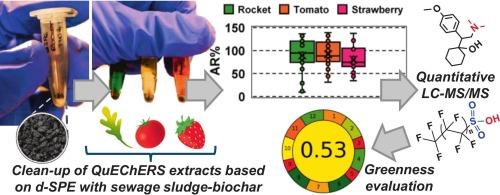污水污泥中的生物炭作为一种可持续的绿色分散固相吸附剂用于QuEChERS萃取物的净化:首次应用于可食用作物样品中新兴污染物的LC-MS /MS分析
IF 4.9
2区 化学
Q1 CHEMISTRY, ANALYTICAL
引用次数: 0
摘要
污水污泥热解的生物炭(SS-BC)首次作为分散固相萃取(d-SPE)吸附剂用于火箭、番茄和草莓的QuEChERS萃取物的清理,用于分析一系列新出现的污染物,其中包括23种属于药物化合物(PhCs)、全氟烷基物质(PFASs)和防晒剂(SAs)的分析物。比较了SS-BC与石墨化炭黑(GCB)和苯乙烯-二乙烯基苯共聚物(SDVB)的净化效果,评价了无基体实验的回收率(R)、基体效应(ME)还原和表观回收率(AR%)。SS-BC在10 mg/mL萃取液中对所有目标分析物均有较高的ME去除率,但回收率变化较大(R% = 67±36),与芳香环的数量呈负相关,与分子的大小和疏水性直接相关。对于PFAS的QuEChERS分析,BC作为d-SPE吸附剂是有效的(AR% = 96% - 136%,取决于所分析的作物),而对于同时分析非芳香族和芳香族分析物,将SS-BC与SDVB适当混合可以获得更好的结果。将提出的QuEChERS提取和清理方法与先前发表的方法进行环境绿色度比较,得分最高(0.53比0.35-0.47)。根据所获得的结果,SS-BC代表了一种可持续且具有成本效益的生物基材料,可以取代GCB作为D - spe吸附剂,用于分析各种色素作物提取物中的各种新出现的污染物,涵盖广泛的物理化学性质(例如,pH = 7,范围为−2-6.8)。本文章由计算机程序翻译,如有差异,请以英文原文为准。

Biochar from sewage sludge as a sustainable and green dispersive solid pHase adsorbent in the clean-up of QuEChERS extracts: First application to the LC–MS/MS analysis of contaminants of emerging concern in edible crop samples
Biochar from pyrolysis of sewage sludge (SS-BC) was tested for the first time as dispersive solid-phase extraction (d-SPE) sorbent in the clean-up of QuEChERS extracts of rocket, tomato, and strawberry for the analysis of a wide group of contaminants of emerging concern, which included 23 analytes belonging to the classes of pharmaceutical compounds (PhCs), perfluorinated alkyl substances (PFASs), and sunscreen agents (SAs). The SS-BC was compared for its clean-up efficiency with graphitized carbon black (GCB) and styrene-divinylbenzene copolymer (SDVB), evaluating recovery efficiency (R) in matrix-free experiments, matrix effect (ME) reduction and apparent recovery (AR%). SS-BC at 10 mg/mL of extract showed high ME removals for all target analytes, but variable recoveries (R% = 67 ± 36), inversely and strongly correlated with the number of aromatic rings and directly correlated with the size and hydrophobicity of the molecule. BC was effective as d-SPE sorbent for the QuEChERS analysis of PFAS (AR% = 96 %–136 %, depending on the crop analysed), while for the simultaneous analysis of both non-aromatic and aromatic analytes better results were obtained by properly mixing SS-BC with SDVB. The proposed QuEChERS extraction and clean-up approach was compared for its environmental greenness with previously published methods, showing the highest score (0.53 vs. 0.35–0.47). Based on the results obtained, SS-BC represents a sustainable and cost-effective bio-based material that can replace GCB as d-SPE sorbent for the analysis of a wide variety of emerging contaminants, covering a broad range of physicochemical properties (e.g., Log D at pH = 7 in the range − 2–6.8) in various pigmented crop extracts.
求助全文
通过发布文献求助,成功后即可免费获取论文全文。
去求助
来源期刊

Microchemical Journal
化学-分析化学
CiteScore
8.70
自引率
8.30%
发文量
1131
审稿时长
1.9 months
期刊介绍:
The Microchemical Journal is a peer reviewed journal devoted to all aspects and phases of analytical chemistry and chemical analysis. The Microchemical Journal publishes articles which are at the forefront of modern analytical chemistry and cover innovations in the techniques to the finest possible limits. This includes fundamental aspects, instrumentation, new developments, innovative and novel methods and applications including environmental and clinical field.
Traditional classical analytical methods such as spectrophotometry and titrimetry as well as established instrumentation methods such as flame and graphite furnace atomic absorption spectrometry, gas chromatography, and modified glassy or carbon electrode electrochemical methods will be considered, provided they show significant improvements and novelty compared to the established methods.
 求助内容:
求助内容: 应助结果提醒方式:
应助结果提醒方式:


